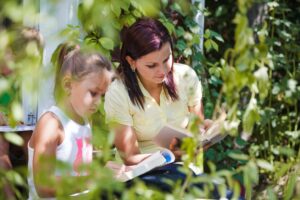In the twenty-first century, the integration of environmental education into language learning has gained traction as educators seek to develop not only communicative competence but also environmental themes. Effective and holistic assessment methods become essential. Traditional testing methods often fall short in capturing the affective, cognitive, and creative dimensions that characterise environmental language learning outcomes. This article explores various innovative assessment methods-ranging from art-based evaluations and capacity frameworks to measures of motivational impact in blended learning environments, and AAC outcome predictors propose a comprehensive approach to evaluating environmental language learning.
Literature Review
Art-Based Evaluation
Art-based assessments offer a valuable means of gauging both the affective and cognitive dimensions of environmental learning. Flowers, Carroll, Green, and Larson (2015) demonstrated that creative outputs such as drawings and collages serve as effective indicators of learners’ environmental perceptions and language use. This approach provides rich qualitative data that complements traditional assessments and captures the nuanced ways in which learners internalise environmental content.
Institutional Capacity Frameworks
At the higher education level, assessment methods that incorporate institutional capacity frameworks provide a macro-level view of program effectiveness. Davis (2016) introduced a capacity framework for evaluating student learning outcomes in college foreign language programs, emphasizing factors such as institutional support, leadership, and curricular infrastructure. Adapting this framework to environmental language learning allows educators to systematically examine how program-level variables influence learning outcomes.
Motivational Measures in Blended Learning
Motivation plays a critical role in language acquisition, particularly in blended learning environments where digital and face-to-face instruction converge. Peng and Fu (2021) found that both intrinsic and extrinsic motivational factors are significant predictors of language learning outcomes. In the context of environmental language learning, authentic, context-rich tasks can boost intrinsic motivation, thereby enhancing both environmental literacy and linguistic performance.

Alternative Communication Outcome Models
For learners who rely on augmentative and alternative communication (AAC), traditional assessments may be insufficient. Brady et al. (2013) developed the
concept of the Intrinsic Symbolic Factor (ISF) to predict vocabulary outcomes in children using AAC. Their work underscores the importance of environmental input, particularly from home environments—in supporting language development. Such models can be adapted to assess environmental language learning outcomes in diverse learner populations.
Process–Product Approaches in Communicative Teaching
Spada’s (n.d.) process–product study of communicative language teaching highlights the need to evaluate both instructional practices (process) and the resulting language outputs (product). Applying this dual approach to environmental language learning can help determine how environmental activities integrated into instruction lead to measurable improvements in language performance.
Discussion
The reviewed methods reveal that no single approach can fully capture the multidimensional outcomes of environmental language learning. Art-based assessments excel at revealing affective and cognitive dimensions through creative expression, yet they may require subjective interpretation. Capacity frameworks offer a systemic view of program effectiveness, but they can be complex and resource-intensive to implement. Motivational studies in blended environments indicate that student engagement is critical; however, such methods must be complemented by direct measures of linguistic performance. AAC outcome measures remind us that diverse learner needs require flexible, multi-modal assessment tools. Finally, process–product approaches ensure that both teaching methods and learner outcomes are scrutinized, advocating for a balanced, holistic evaluation model.
Conclusion
Innovative assessment methods are essential for capturing the complex outcomes of environmental language learning programs. By integrating art-based evaluations, capacity frameworks, motivational measures, alternative communication outcome models, and process–product approaches,
educators can develop a holistic framework that reflects the full spectrum of learning, from linguistic proficiency to environmental literacy. Future research should aim to empirically test and refine this integrative framework, ensuring its applicability across diverse educational settings and learner populations.
Follow us on Facebook & Instagram to stay tuned.
References
Brady, N. C., Thiemann-Bourque, K., Fleming, K., & Matthews, K. (2013). Predicting language outcomes for children learning AAC: Child and environmental factors. Journal of Speech, Language, and Hearing Research, 56(5), 1595–1612. https://doi.org/10.1044/1092-4388(2013/12-0102)
Davis, J. M. D. (2016). Toward a capacity framework for useful student learning outcomes assessment in college foreign language programs. The Modern Language Journal, 100(1), 377–399. https://doi.org/10.1111/modl.12319
Flowers, A. A., Carroll, J. P., Green, G. T., & Larson, L. R. (2015). Using art to assess environmental education outcomes. Environmental Education Research, 21(6), 846–864. https://doi.org/10.1080/13504622.2014.959473
Peng, R., & Fu, R. (2021). The effect of Chinese EFL students’ learning motivation on learning outcomes within a blended learning environment. Australasian Journal of Educational Technology, 37(6).
Spada, N. (n.d.). Relationships between instructional differences and learning outcomes: A process–product study of communicative language teaching. McGill University.

